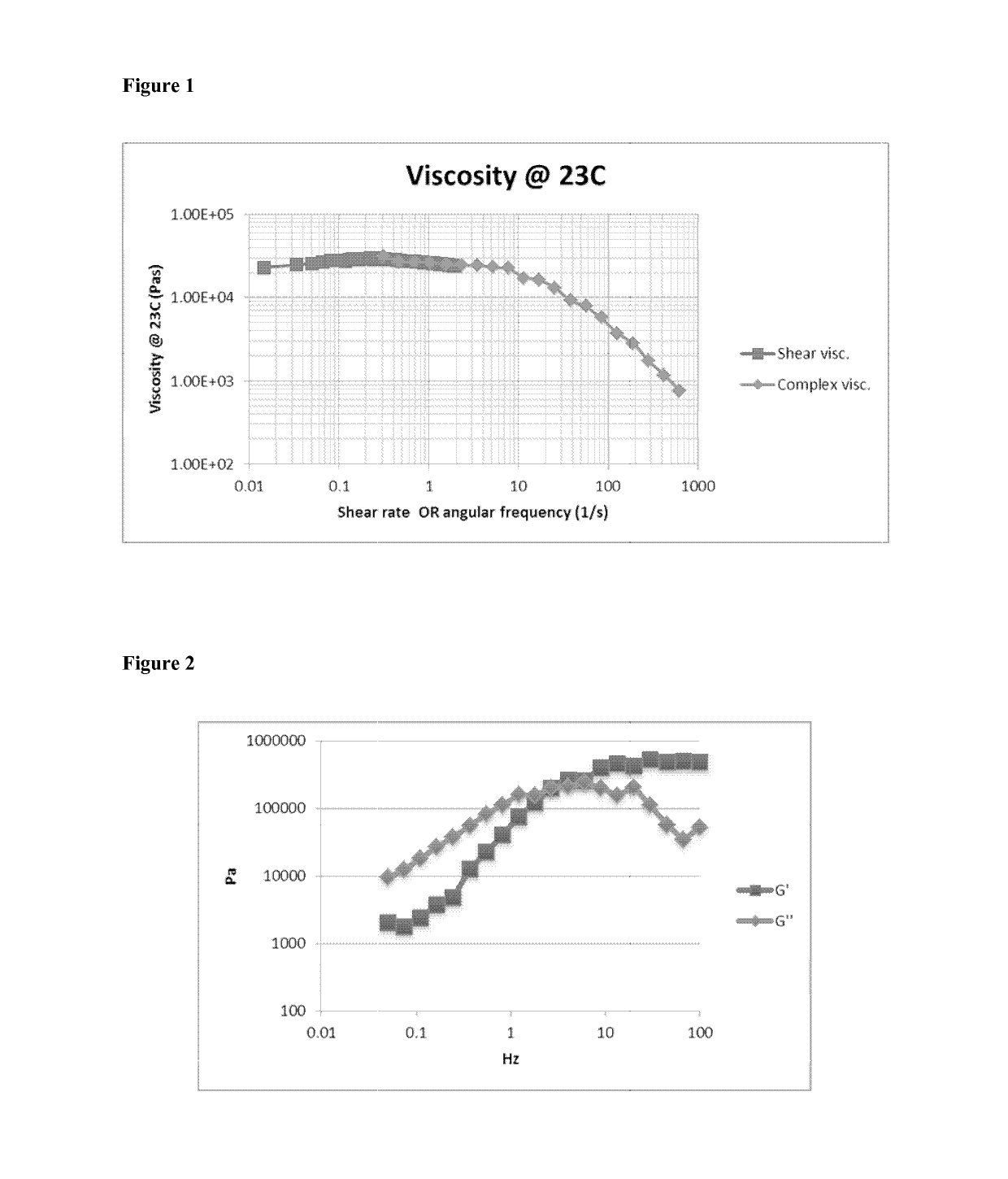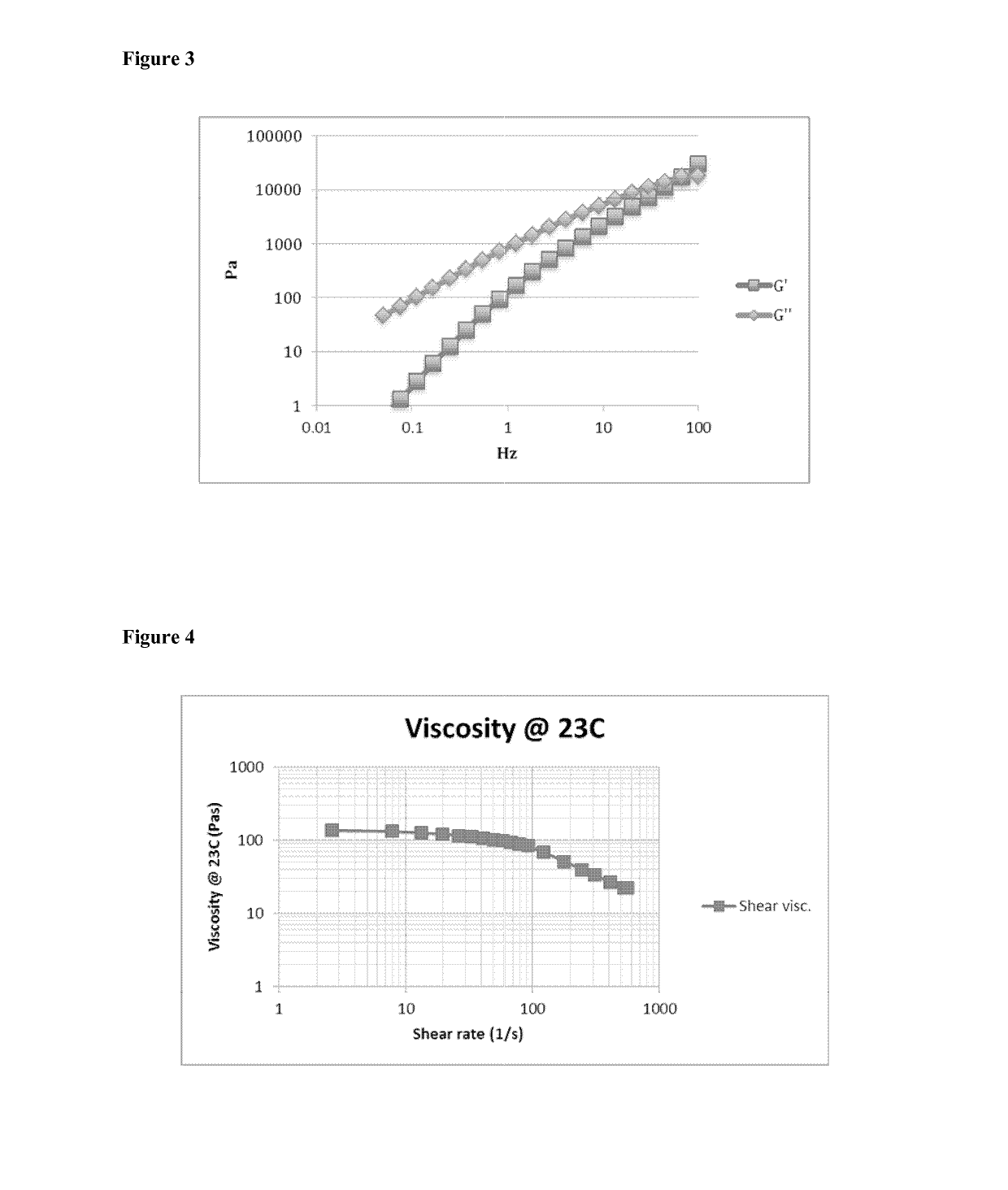Crosslinked siloxanyl polymer compositions
a technology of polymer compositions and siloxanyl, which is applied in the field of crosslinked siloxanyl polymer compositions, can solve the problems of limiting the use of materials, affecting the health of humans, and excluding their use in other applications
- Summary
- Abstract
- Description
- Claims
- Application Information
AI Technical Summary
Benefits of technology
Problems solved by technology
Method used
Image
Examples
example 1
[0228]Reduction of the amount of boron containing compound results in loss of desired properties well before the content of boron containing substance is below the levels stipulated by the European Union. A series of bouncing putties in which the boric acid content was varied was prepared in the following way: A saturated aqueous solution of boric acid was prepared, which at 25° C. has a concentration corresponding to 5.4% wt. The saturated boric acid solution was mixed with a hydroxyl-terminated polydimethylsiloxane; WACKER® POLYMER CDS 100 (molecular weight of about 4000 Dalton and viscosity ca. 100 cP, as given by the manufacturer Wacker Chemie AG). Water was evaporated during continuous stirring of the mixture and the properties of the final mixture were evaluated. The bouncing property was evaluated by dropping a ball (0.4 g) from a height of 2 m onto a flat glass surface. Table 1 shows that loss of properties was observed below a molar ratio of 1:1 (boric acid:PDMS) correspond...
example 2
[0230]An increase in molecular weight of the polydimethylsiloxane (PDMS) chain used as starting material results in a loss of the desired properties before the content of boron containing substance is sufficiently low. A series of bouncing putties, prepared as described in Example 1, with WACKER® POLYMER C 2 T (molecular weight of about 25000 Dalton and viscosity ca. 2000 cP, as given by the manufacturer Wacker Chemie AG) shows that essential properties are lost already at a molecular weight at and above 25000 since none of the samples in Table 2 has desired properties. Yet the concentration of boric acid is above the levels stipulated by the European Union.
[0231]
TABLE 2MolarratioWACKER ®SaturatedboricBoricBouncePOLYMER C 2BinderFillerVoidsboric acidacid:CacidBoronfrom 2 mT (g)(% vol)(% vol)(% vol)solution (g)2 T(% wt)(% wt)Observation(cm)1100000.0230.5:1 0.120.021No noticeable increaseNonein viscosity1100000.0340.75:1 0.180.031Minor viscosityNoneincrease - soft texture,but still ...
example 3
[0232]Addition of inactive filler material results in loss of the desired properties before the content of boron containing substance is sufficiently low. A series of bouncing putties with increased filler content shows a loss of properties at filler contents above 40% wt. All samples were based on WACKER® POLYMER CDS 100 with a molar ratio of 1:1 (boric acid: CDS 100), and as filler was used hydrophilic amorphous pyrogenic silica; WACKER® HDK® N20. The putties were prepared as described in Example 1, and filler was added by kneading. Sometimes a small amount of ethanol was used as processing liquid, which was evaporated in the late stages. By preparing samples both with, as well as without ethanol it was verified that properties of the putty was not affected by the use of the processing solvent. Table 3 shows loss of properties well before content of the boric acid is sufficiently low.
[0233]
TABLE 3BoricBounceBouncingWACKER ®BinderFilleracidBoronfrom 2 mputty (g)HDK ® N20 (g)(% wt)(...
PUM
| Property | Measurement | Unit |
|---|---|---|
| vol. % | aaaaa | aaaaa |
| height | aaaaa | aaaaa |
| height | aaaaa | aaaaa |
Abstract
Description
Claims
Application Information
 Login to View More
Login to View More - R&D
- Intellectual Property
- Life Sciences
- Materials
- Tech Scout
- Unparalleled Data Quality
- Higher Quality Content
- 60% Fewer Hallucinations
Browse by: Latest US Patents, China's latest patents, Technical Efficacy Thesaurus, Application Domain, Technology Topic, Popular Technical Reports.
© 2025 PatSnap. All rights reserved.Legal|Privacy policy|Modern Slavery Act Transparency Statement|Sitemap|About US| Contact US: help@patsnap.com


